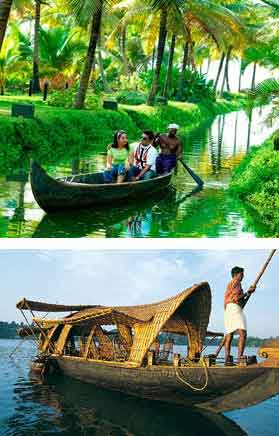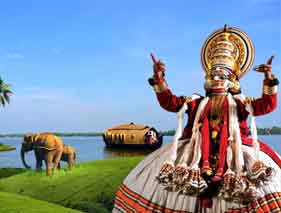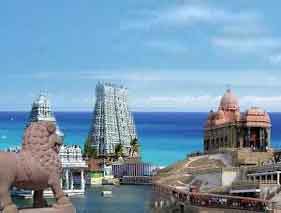Itinerary Details
Day 01 ARRIVE DELHI
You will met on arrival in Delhi and get transferred to the hotel and overnight stay.
On arrival check in at Hotel. Dinner and overnight at the hotel.
Day 02 IN COCHIN:
Morning you will get transferred to the airport to board flight for Cochin. Assisted on arrival and transfer to your hotel in Cochin. Later explore the city
Explore Cochin, which comprises of a cluster of islands and towns. Fort Cochin is believed to be the oldest European settlement in India, with the Portuguese flag first hoisted here in 1500. St. Francis Church, built in 1510 by friars brought to India by Vasco da Gama, is the first European church built in India and is the site where da Gama was buried. While the remains were later taken back to Lisbon, the gravestone can still be seen here. The Jewish Synagogue was built in 1568 and considerably embellished in the mid 18th century by Ezekiel Rahabi, who built a clock tower and paved the floor of the synagogue with hand-painted tiles brought all the way from Canton in China. The "Dutch Palace" was built in the 1550s by the Portuguese and taken over by the Dutch, who later presented it to the Rajas of Cochin. The palace contains excellent mythological murals and a rare example of traditional Keralite flooring - a subtle mix of burnt coconut shells, lime, plant juices and eggwhites - which gives the effect of polished marble.
In the evening witness a Kathakali dance performance. This is the most developed dance drama art of India. Drums beckon an audience to a performance most magnificent - actors depict characters from the Puranas and the Mahabharata, the great Indian epics - demons, superhuman beings and ordinary men and women. The dancers, all male, adorn themselves in huge skirts and elaborate headdress, wearing what must surely be the most intricate make up known to any dance style in the world. Dialogue is combined with dance to bring myth and legend to life in the temple courtyards of Kerala. Dinner and overnight at Hotel.
Day 3 DRIVE TO MUNNAR
After breakfast drive to Munnar. Approx 4 hours drive will take you to this beautiful hill station. Check in at your hotel and later explore the surroundings.
A major center of Kerala’s tea industry and close to Anaimudi, at 2695 m highest peak in South India, Munnar is the nearest Kerala comes to a genuine hill station. It is surrounded by about 30 estates, amount the highest in the world, and the forest that is still rich in wildlife, including the reclusive Nilgiri Tahr that continues to survive the increasing the commercial use of the hills. The surrounding hills are home to the rare Neelakurunji plant (Strobilanthes), which covers the hills in colour for a month once in 12 years. Overnight stay in Munnar
Day 04 IN MUNNAR
Enjoy teh day in Munnar and another overnight stay
Day 05 DRIVE TO PERIYAR
The journey ends at the prosperous town of Kottayam, an important trading centre and the first town in India to attain 100% literacy. Nestled in the foothills of the Western Ghats, it has beautiful backwaters to its west and scenic fertile mountains to its east. A major centre of the trade, Kottayam also has a strong spiritual side to it, with several sects and divisions of the Syrian Christian faith due to the influence of history over the centuries. The best known churches are the historic Valia Palli and Cheria Palli, both with colourful frescoes enriching their dim interiors.
The coach will meet you at Kottayam for the drive to the Periyar Tiger Reserve and National Park. On arrival check in at Hotel Shalimar Spice Garden.
In the afternoon explore the park. Established in 1934 as the Nelliampatty Sanctuary, the park was enlarged in 1950 and is India's southernmost tiger reserve. The lake covers some 10 sq. miles and most of the sanctuary is undulating. Since boat travel is the only means of transport in the park, large areas can be covered in a short time. Among the game found here are gaur (the largest of the world's wild oxen), elephant, wild pig, sambar, barking deer, mouse deer, the rare and endangered lion-tailed macaque, the Nilgiri langur, the common langur and the bonnet macaque, porcupine, Malabar squirrel, wild dog and tiger. Among the birds commonly seen are darters, cormorant, osprey, kingfisher and kite, great hornbill, grey hornbill, hill mynas, orioles and racket-tailed drongos. Dinner and overnight at Hotel Shalimar Spice Garden.
Day 06 PERIYAR /ALLEPPEY:
After breakfast drive to Alleppey, known as the "Venice of the East", situated on the Vembabad Lake, the longest lake in India. A maze of canals and a network of bridges give this busy commercial town its descriptive sobriquet. Alleppey is known for its coir, the retted fiber of the coconut husk and for black pepper. Coir yarn, mats and matting and a wealth of other coir products are manufactured here and are good buys.
Board the Rice Boats to begin a fascinating journey through forests, palm-shaded backwaters and canals. The leisurely cruise on the beautiful backwaters offers magnificent scenery along the waterways and an unique insight into the history, lifestyle, culture and religion of the region. Dinner and overnight on the Rice Boats.
Day 07 DRIVE TO KOVALAM
After leisurely breakfast drive to Kovalam. Stop in Trivandrum to explore the best of it.
The capital of the state of Kerala, Trivandrum or Tiruvananthapuram, is a beautiful seaside city build on hills overlooking quiet verdant valleys. The Padmanabhaswamy Temple is dedicated to the serpent Anantha, on which Lord Vishnu reclines and is a sacred place of pilgrimage for Hindus since antiquity. With its magnificent tower rising in seven storeys against the reflecting pool in front, the temple is a fine specimen of South Indian architecture. Napier Art Museum is a colourful and attractive turreted structure with gothic roof and minarets. The painted walls and ceilings have copies of the Ajanta and Sigirya frescos, miniatures from the Rajput, Mughal and Tanjore schools, works from China, Japan and Bali as well as canvasses by modern Indian painters.
Further 10 - 15 Kms drive will take you to the beach. Check in at your resort and overnight stay.
Day 08 IN KOVALAM
Kovalam Beach is a natural bay, sheltered from high waves and surges. You can experience an Aryuvedic massage, famed for its rejuvenating qualities. Aryuveda is the traditional system of medicine practiced in Kerala for centuries. The potions are prepared from herbs.
Day 09 IN KOVALAM
Another day for relax at your beach resort.
Day 10 DRIVE TO KANYAKUMARI
Morning drive south to reach at the last road end at Kanyakumari. Extreme south of Indian boundaries. Kanya Kumari, the southern-most tip of India, where three seas meet. The shore temple to the virgin goddess Kaniyakumari is one of the sacred places of the Hindus. The temple is magnificently sculpted and the goddess in its sanctum a creation of rare beauty. The Gandhi Mandapam, built in the Kalinga style, commemorates the immersion of the ashes of Mahatma Gandhi in the waters by the temple.
Overnight stay in Kanyakumari.
Day 11 DRIVE TO MADURAI
After breakfast depart on the drive to Madurai, known as the City of Festivals. On arrival check in at Hotel. Approx 6 hours drive will take to Madurai. Check in at the hotel and afternoon explore the best of it.
Day 12 IN MADURAI
Madurai, which is the most ancient home of culture, with the first Tamil Academy being founded here by scholars and pious kings. The town has developed around the famous Meenakshi temple, built in the Dravidian style, dedicated to Lord Shiva and his spouse Meenakshi. The Court of Thousand Pillars, built in 1560, has lovely sculptures. Outside the temple are the Musical Pillars which produce different 'swaras' or notes when tapped. The Vasanth Mandapam has life-size statues of the Nayakas of Madurai. Dinner and overnight at Hotel Pandyan.
Day 13 MADURAI/TRICY:
After breakfast drive to Tiruchirapalli, also known as Trichy. On arrival check in at Hotel Sangam.
In the afternoon explore this historic town which was held by the Chola and Pallava dynasties. The Nayakas of Madurai have constructed the greater portion of the town. The Trichy Fort played an important part in the battles waged between the English and the French to gain power. The Rock Fort is a landmark of Trichy and contains excavated cave temples dating back to the 7th century, the Hall of a hundred Pillars and a Ganesha temple on its summit. On the island of Srirangam is a massive Vishnu temple with seven walls. Dinner and overnight at Hotel Sangam.
Day 14 TRICHY/TANJORE/TRICHY:
After breakfast depart on a day trip to Tanjore or Tanjavur as it was earlier called. Tanjore was the capital of the Chola empire from the 10th to the 14th centuries. Later it became part of the Vijayanagar kingdom, then passed into the hands of the Marathas and later still went to the British. For ages it has been the chief political, literary and religious centre of the south. The celebrated temple of Brihadeshwara, built by the Chola king Raja the Great during the 11th century, is its major attraction. The Saraswasti Mahal library, dating from the time of the Marathas, contains a rare collection of books and manuscripts on paper and palm-leaf. return to Trichy for dinner and overnight stay at Hotel Sangam.
Day 15 TRICHY/PONDICHERRY:
After breakfast depart for Pondicherry. En route visit Chidambaram, where the celebrated Nataraja temple - the temple of the Dancing Shiva - is situated. The god Shiva performed his cosmic dance after humbling several conceited rishis (sagas) who believed they had acquired extraordinary powers through their rigorous austerities. Much of the temple as seen today was built by the Chola emperors. massive gopurams soar over great entrances. There are several shrines in the temple complex, including one for the god Vishnu. The sanctum sanctorum enshrines the god in his dance pose. Adjacent to it is the sanctum of the goddess whose name here is Shivakamasundari - “the beautiful woman who evoked the love of Shiva”. An unusual shrine is one without an image in it; this is known as the secret of Chidambaram - the implication being that god is to be found everywhere, especially in the heart. On arrival in Pondicherry check in at Hotel Anandha Inn for dinner and overnight stay.
Day 16 PONDICHERRY/MAHABALIPURAM:
In the morning explore Pondicherry. Spend some time at the Aurobindo Ashram which is the best known landmark of Pondicherry. Other places of interest include the Raj Nivas, residence of the Lieutenant Governor of Pondicherry, a handsome 200-year old building which was once the residence of the Marquis Joseph-Francois Dupleix, the builder of Pondicherry. The Romain Rolland Library has over 60,000 volumes of rate French and English books. The Pondicherry Museum has an outstanding collection of artifacts, especially relating to all aspects of the French Indian past and retains a French ambiance. The Church of the Sacred Heart of Jesus, Gothic in style and serene in atmosphere, has three large stained-glass panels that tell the life of Jesus and many arches that span the nave. The Botanical Gardens were set up in 1826 and have grown over the decades to become one of the best botanical gardens in the South, with unusual and exotic plants from all over the country and abroad. The Church of Notre Dame des Anges, built around 1865, is a striking structure with twin square towers and houses a rare oil painting gifted by Napoleon III. The Institute of Indology was established in the mid 1950s and is today an internationally renowned research organization providing an abiding link between France and India. Ananda Ranga Pillai’s House, architecturally a fusion of the French and Indian styles, is a graceful building, lavishly furnished and decorated, which has been converted into a museum.
Continue on to Mahabalipuram, the port city of the Pallavas in the 7th century. In this picturesque setting of sandy beaches and the sea can be seen some 70 monuments that influenced temple architecture in Tamil Nadu for centuries to come. On arrival check in at hotel for dinner and overnight stay.
Day 17 MAHABALIPURAM/KANCHIPURAM/MAHABALIPURAM:
In the morning explore Mahabalipuram. The first important group is formed by the five rathas - rock-cut monoliths named after the heroes of the Mahabharata which simulate ceremonial chariots. Some of these rathas are unfinished and in them can be seen the carving technique used to form temples out of living rock. Also within this complex are large sculptures of a lion, an elephant and a seated Nandi (the bull) Lord Shiva's mount. The other cave temples of Mahishasuramardini and Olalkkannesware (God of the Flaming Eye) are carved out of the hillside to form pillared halls and enclosed shrines within which are some magnificent sculptures, some larger than life, of gods and goddesses of the Hindu pantheon.
Continue on to Kanchipuram which was the erstwhile capital of the Pallavas and Cholas who reigned between the 7th and 13th centuries. These two powerful dynasties gave the city its numerous temples and tanks. The town today has as many as 150 active temples dedicated to various gods and goddesses. One of the seven holiest cities of India, it is well planned, with broad streets designed to accommodate the large processions that take place throughout the year in celebration of festivals dedicated to the many and various deities. The Kailashanatha and Vaikuntaperumal Vishnu temples were both built in the 8th century of sandstone and house some of the most elegant sculptures of Shiva, Nataraja, Durga mounted on a lion and of Vishnu. The former also contains some remnants of mural paintings from the Pallava period. The Varadaraja Vishnu temple is a large complex with mandapas, tanks and sculptured halls. It has an ancient mango tree; the four branches are said to represent the four Vedas, and each has a different taste. To eat the fruit is to gain eternal wisdom. The Ekambareshwara temple is also a large complex where devotees still flock in large numbers. Return to Mahabalipuram in the evening for dinner and overnight at MGM Beach Resort.
Day 18 IN MAHABALIPURAM:
Day at leisure. Breakfast, dinner and overnight at Beach Resort.
Day 19 MAHABALIPURAM/CHENNAI:
Morning at leisure. In the afternoon drive to Chennai for a tour of the city. The gateway to the sunny south, Chennai, the capital of Tamil Nadu, is also a seat of ancient civilization, with a rich heritage of fine arts, sculpture and architecture. It has withstood the pressure of modernization to some extent and even today retains an old-world charm which has an instant appeal for the visitor. The British East India Company established one of its earliest seats of power in India in Madras. The construction of Fort St. George was begun around 1650. Today the old buildings in the fort house the Tamil Nadu Government Secretariat and the Legislative Assembly. St. Mary's Church, consecrated in 1680, is the earliest English building surviving intact in India and also the earliest Anglican church in the east. The Fort St. George Museum contains some fascinating items belonging to the early days of the East India Company and the colonial period - coins, weapons, pictures and books form part of the collection. Two beautiful churches that still have regular services are St. George's Cathedral and St. Andrew's Kirk. The latter is said to resemble St. Martin-in-the-Fields in London and its towering steeples and the strength of the pillars of the facade make it a city landmark. The Ice Factory on Marina Beach was built in 1842 to store ice imported from America. It was later converted into a home for widows. San Thome Church is associated with the Apostle St. Thomas. It is believed that he was martyred on St. Thomas' Mount and his remains are enshrined in this church. The Marina, is a 13-km long sandy beach running along the whole length of Madras, fringed with palms and casuarinas. One of the most important localities of Madras is the unified complex of Mylapore where the Kapaleswara Shiva temple, the tank, market area and old Brahmin residential houses are situated. Another ancient and important place of worship is the Krishna Patrathasarathy temple. Overnight in Chennai
Day 20 DEPARTURE CHENNAI/ DELHI.
After breakfast you will get transferred to the airport in time to board flight for onward destination






